When you compare a 1954 Studebaker Champion DeLuxe Starlight to a lot of the other dreck that was rolling off of American automobile assembly lines that year, you have to wonder how Studebaker ended up essentially gone in just about another ten years. OK, so ten years was an eternity in those days as technological and styling changes amassed quickly, but still, what a looker of a car! This example is a Deluxe Starlight trim level and it still, 68 years after the fact, has an impressive bearing about itself. Discovered by T.J., it’s located in San Francisco, California and is available, here on eBay for a current bid of $6,000 with thirteen bids tendered so far.
Studebaker’s downfall had a lot more to do with things that were beyond skin deep, and that unfortunate turn of events has been discussed many times before here on B.F. But it would seem that Studebaker understood the competitive fight and saw a foothole with standout styling coming from the likes of industrial designer Raymond Loewy’s studio. The Champion name is a storied one for the Scion of South Bend having been first used in 1939 but really finding its stylized way with the 1953 introduction of the fourth-generation version. It was short-lived as after ’54, the Champ started to take on more ordinary styling characteristics which continued into the fifth (’57-’58) and final generation. Total Studebaker production for ’54 was rather anemic with a total output of only 68K units, rendering it a thirteenth place finish. For perspective, number one Ford rang out 1.1 M copies that year.
Instead of just paraphrasing the seller, I’ll copy his words, “Body has some rust underneath, mainly the driver’s side cross member, but floorboards and trunk are mostly solid. Front fenders are fiberglass replacements. Paint looks good from 20 feet but close-up is in fair to poor quality with some cracking in various areas. Hood has heavy orange peel. Chrome is very good…” I find the fiberglass fender replacement to be a different twist, one would assume that they would be steel. This car does indeed look good from twenty feet, the Stafford Cream body with the black finished roof matches the image used in the ’54 Studebaker sales brochure and makes a statement but in a subtle way. The chrome and stainless trim look sharp and it’s nice to find the original wheel covers.
The interior is a bit dreary, though I’m sure it wasn’t many years ago. The red vinyl upholstery has faded to pink and there are obvious splits in places. The seller mentions the carpet needs to be replaced and the rear upholstery panels are showing signs of age-induced sagging. But all-in-all, it’s in reasonably good condition – it does need a rear center armrest – no idea how hard that will be to source.
In the engine room is an 85 HP, 169 CI, in-line six-cylinder engine engaged to a three-speed manual transmission. The seller advises, “Car runs and drives very well but several wires are missing(no lights), and currently running on a 12-volt battery, not the original 6-volt battery. Needs a new wiring harness, plus a voltage regulator and solenoid. Also has overdrive but not working. A complete wiring harness sells for around $400…” I’m not sure what one is supposed to change to go from a six-volt base to a twelve but that might be the reason for some of this car’s issues.
A stylish two-door coupe from a fallen flag, oh yeah, this one needs to be saved. And it’s a sound base that can be improved over time, probably starting with the electrical matters first, aesthetics can wait until later. If the bidding stays moderate, this could be a good pick up wouldn’t you agree?



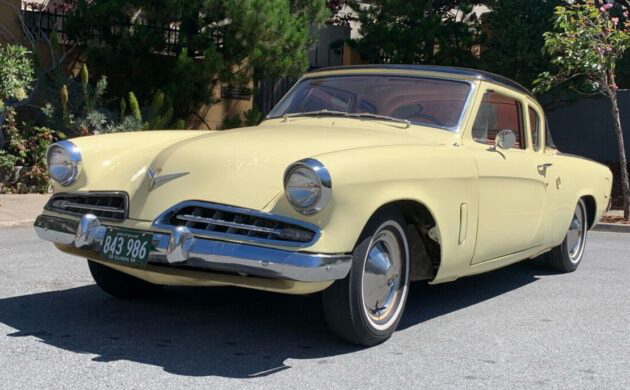
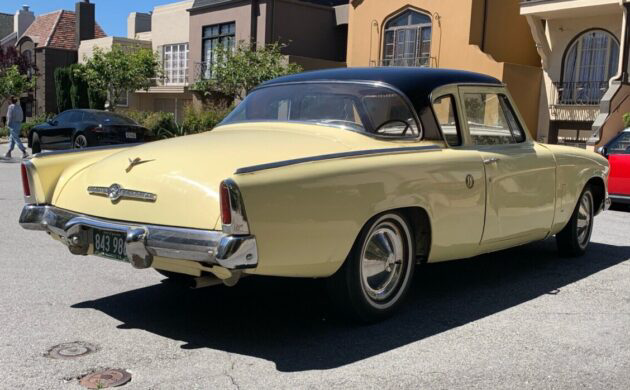
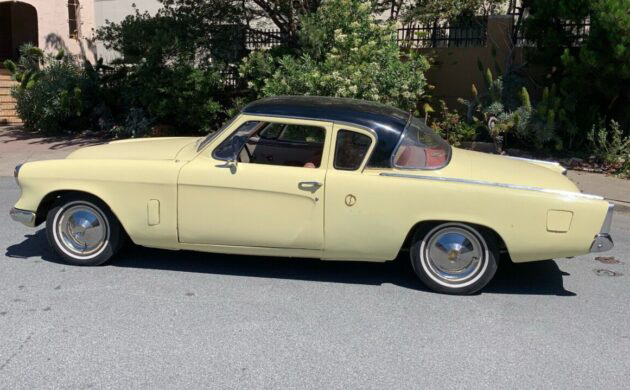

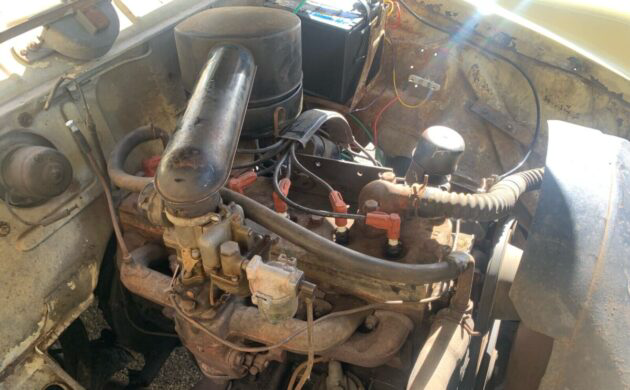
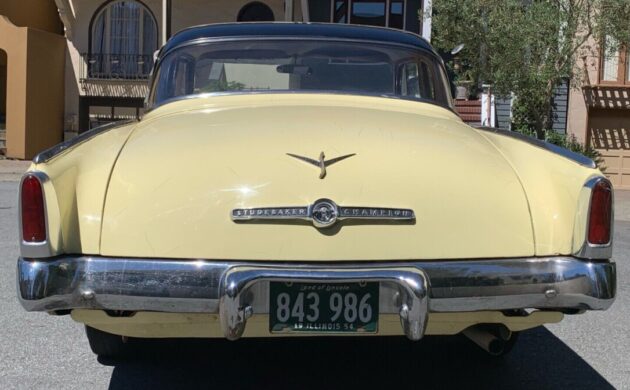
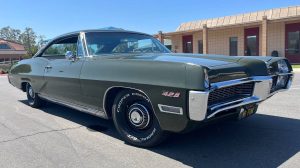
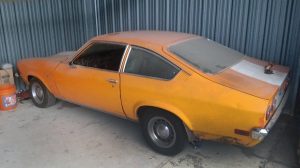
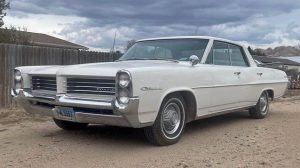
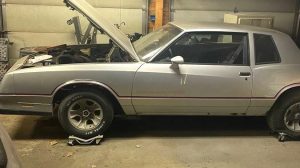


Gorgeous cars. The color and 6 cylinder engine don’t do it justice but the styling is timeless.
This has resto-mod written all over it. 3000 miles away or I might be a bidder. I had one in much rougher shape (that a friend kidded me for turning it into a shed) that had a 62 Hawk 289 in it. Had to sell it when I moved house. Always sorry.
A six? Fiberglass front fenders? Where did those come from? Three speed manual?
‘In the engine room is an 85 HP, 169 CI, in-line six-cylinder engine’… in-line FLATHEAD six.
How often do you see one?
Just as it sits it’s fascinating.
On my Island Of Misfit Cars it would remain as it came: 6, manual [perhaps an overdrive retrofit].
http://www.oldcarbrochures.com/static/NA/Studebaker/1954%20Studebaker/1954%20Studebaker%20Full%20Line%20Prestige%20Brochure/image19.html
http://www.oldcarbrochures.com/static/NA/Studebaker/1954%20Studebaker/1954%20Studebaker%20Full%20Line%20Prestige%20Brochure/image17.html
Perfect for the coming $8.00 a gallon gas
Psychofish2,
By the late 1960s front fenders for 1953-56 Studebaker 2-door cars were in short supply because they rusted terribly along the rear part of the fender, due to a sheet metal support behind the exterior of the fender that allowed mud to pack into the area. And due to the location of that support, the back side of the fender skin was never painted, so the rust began within weeks for cars in wetter locales. South Bend ran out of the coupe/hardtop front fenders around 1970 [the sedans were shorter fenders and did not interchange with the coupes or hardtops].
So my good friend Dan Webber here in Maryland began working with a fiberglass molding company in Ellicott City, and not long after that he started selling the coupe front fenders, followed a few years later by offering fiberglass 1959-63 Lark front fenders as well.
As far as I can determine, the 1953-56 Studebakers were the only postwar American cars to have different fenders for sedans and coupes on the same basic car. I’ve seen what a sedan front end looks like when someone tried to put them on a coupe, the overall proportions of the care are just wrong! That flowing coupe body NEEDS those longer front fenders to keep the look Studebaker designer Bob Bourke [with some minor help from Raymond Loewy] was able to create.
There is an unusual reason why the coupe fenders were in short supply; Traditionally up thru the 1952 model year, Studebaker had sold about 80% sedans to 20% coupes. So they set up production schedules to make and send to the dealers cars based on that 80/20 mix.
Problem was, the buying public fell in love with the lines of the 2-door cars, and it was almost the exact reverse of sales. Dealers had a hard time selling sedans for a change, and deliveries of the 2-door coupes and hardtops were only trickling in due to lack of body, frame, and trim parts needed to build the 2-doors. Like most car manufacturers, the companies had sub-contractor suppliers for many of the smaller trim parts and the longer frames. It took them a long time to spool up production of the needed coupe parts.
Studebaker always had a low supply of coupe fenders, and far too many sedan fenders. On a visit to the factory in 1970, back when the parts division manager [Denny] would allow people like myself [who bought a lot of parts], to wander all thru the parts racks, during that 1970 trip I was on the top [8th?] floor, I saw where a section of the brick wall had been busted out, and they were using forklift trucks to push large numbers of “slow selling” body parts out the hole in the wall, where they would fall into waiting open railroad gondola cars, to be turned into scrap metal. Most of the remaining sedan fenders were scrapped, along with probably around 75% of the pre-WW2 body parts.
I watched in awe as forklifts would slide their forks thru the door window openings of complete, unpainted 1950s Studebaker Transtar pickup cabs, pick ’em up and push ’em out the hole. My friend Dan talked Denny into selling him a Transtar cab as a replacement for his own rusty one, and the price was so cheap the shipping cost was twice the purchase cost!
I remember Dan fondly. When I first went to South Bend in 1970 Standard Surplus had sedan fenders piled to the second floor. Only a few left front coupe fenders were left for $35.00 The rear coupe fenders were $20.00. At SASCO I always dealt with Carl Thompson. I am sure you remember him too Bill. It is really had to believe how cheap things were in those days.
Vince,
Dan and I lived in the same suburban Washington DC town of Kensington, MD. While I was already a Packard nut, he was the person who got me interested in Studebakers. I always enjoyed spending hours talking cars with him.
In 1972 I was stationed in Ft Dix NJ, and I had a military job that gave me the opportunity to explore the extended geographical area, so Dan gave me an extra copy of the factory list of all the Studebaker dealers, dated 1958, with regular updates to 1966. I wanted Packard parts, Dan of course wanted Studebaker parts, so we agreed I would negotiate any remaining S-P parts inventories, and Dan would keep the Studebaker stuff. We were both flabbergasted at just how many dealership parts departments were still around, and just how cheap we could buy entire inventories, some were even given to me free if I would take them away.
One of the best deals was made in Mt. Joy, NJ, when I pulled into a local ESSO gas station in my 1955 Packard 400 hardtop to get gas. The station owner came out and said his father had owned the local Packard Dealership [not Studebaker]. I asked what happened to the parts, and I was told when the dealership closed in 1956, his dad had everything [parts, service tools, even showroom stuff like banners] moved to the basement in his huge Victorian mansion nearby. Said it was still there, so I followed him home, as he now lived in the house.
He said that he was under pressure from his wife to have all of it hauled off for junk, so she could have the basement turned into a family room and a couple of bedrooms, plus they could get the garage back to use for a car. We went into the kitchen and he opened the door to the basement. He went first down the stairs and began pulling the strings to turn on the light bulbs. I found the entire parts department, right down to the wooden shelving, was 100% complete. Boxes of showroom brochures, and much more.
I was worried I wouldn’t be able to afford this hoard, so I asked him how much? I will never forget his reply: “I won’t take less than $125 for it all”. He was willing to accept my personal check, so I loaded up the Packard with all sorts of chrome goodies and accessories. On the way home I stopped off at a friend’s home in Baltimore, his family collected and restored Packards,& I sold him more than enough to cover the $125 check I had written earlier that day.
Ended up renting a U-Haul truck to get the place emptied out the next weekend, the only thing I left behind was a brand new Packard 288 short block in it’s wooden case, as I had no way of getting it out of the basement, and back then no one wanted a 288 motor anyway, even a NOS version.
Dan’s offer of a loan of that book, was how I got started in the Packard Parts business. I was horrified to hear how he passed away as a result of a terrible highway accident some years ago.
Do you know the details on how Dan became interested in Studebakers?
Hi — I’ve been sort’a lurking here for a couple of months, watching the Studebakers, and folks comments come and go. I am about a 25-year member of THE STUDEBAKER DRIVERS CLUB (or SDC), and have a ’63 GT Hawk that I have “rebuilt” over about 10 of those years. It is largely due to the existence of the SDC that I was able to “re-build” my Hawk from — basically, a hulk/parts car. My purpose in posting here is to see if I can assist any others in realizing that 1) SDC members are all over the world. 2)SDC Vendors can literally supply ANY PART for ALMOST ANY STUDEBAKER (auto) ever built. 3) The members of SDC LOVE to assist any & all who have an interest in our brand, as my re-built Hawk testifies. Absent the assistance of literally dozens of fellow “Stude-Nuts” my Hawk would have been junked. I’m doing this post because I see lots of folks here who seem intimidated by the thought of exploring the ownership/maintenance/repair of one or another of the “Studies” that appear here from day-to-day. For any who have interest in these cars, their history, the “Stude Story”, etc., may I suggest a visit to the SDC web-site for genuine info and the good people of the SDC. Google Studebaker Drivers Club and have fun! TTYL — GP
My fifth car in life was a ’53 B pillar coupe that originally had the V8 but was stripped of the drive train except for the rear axle. $36 dollars for a rust free chassis from the local wrecking yard. My college roommate had a big Olds powered stick shift on the floor ’53 hard top that we used to tow it home after putting wheels and tires on it. Within a year it had a medium blue metallic paint job and new blue and white interior over a 311 cu inch Olds engine and 4 speed Hydromatic transmission. Ask me if I wouldn’t love to have that car back. Glad to see you are out there GP 63 Hawk.
I agree, the SDC was a very helpful source when I had my ‘57 Silver Hawk.
I’m with bobhess; the styling is timeless. I am about three hours from this car and I have no room. Negotiations for more space going on, but I can’t buy anything now as much as I would want this one.
If this car could have been ordered with the Stude V8 and maybe a super charger, I would carefully 1. Remove and store this six cylinder and 2 install the aforementioned V8 . Beautiful lines, wish it were mine.
Kurt,
Studebaker offered 2 series of cars during 1954, the Champion and the Commander. Champions had the flathead six, the Commanders had the new V8.
The supercharged [McCulloch] engines came out for the Golden Hawk in 1957 and 1958, and the Paxton superchargers were available from 1963 until the end of South Bend production.
Thanks Bill. I bet the supercharged V8 really moved down the road at an expeditious rate!
Fuel is $8.00+ in Porto this Sunday ..,,
The 2 door hardtop was much better looking. Maybe if you painted the B pillar and window surrounds black to match the top would look better.